Welcome to Card Game DB
Register now to gain access to all of our features. Once registered and logged in, you will be able to create topics, post replies to existing threads, give reputation to your fellow members, get your own private messenger, post status updates, manage your profile and so much more. If you already have an account, login here - otherwise create an account for free today!
Register now to gain access to all of our features. Once registered and logged in, you will be able to create topics, post replies to existing threads, give reputation to your fellow members, get your own private messenger, post status updates, manage your profile and so much more. If you already have an account, login here - otherwise create an account for free today!
Quill & Tankard Regulars - Volume 2, Issue 14
Mar 21 2017 05:25 PM |
WWDrakey
in Articles
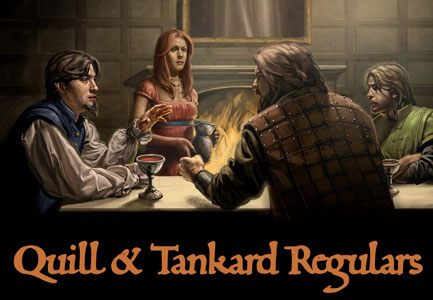 Quill & Tankard Regulars - Volume 2, Issue 14
Quill & Tankard Regulars - Volume 2, Issue 14Okay, so repeat again what happened here.
‘Tw’s un’ b’ld’e. E’ dunnit!
Indeed. So… what was this hair-challenged person after?
‘E w’nted soddin’ ‘ine! Bl’smephy!
Ok. Now, while I can understand the dire circumstances… what happened with our other patrons?
‘e ‘ed ‘un n’me ‘un ‘e buggers leggit!
Huh. And the log? Everything else I can somehow stomach, but what’s up with the log right in the center of the tavern?
The Raven’s Message
The Raven’s Message exclusively reveals and discusses an up-and-coming, either mechanically or rules-wise interesting, card. The cards are from future products, and have been obtained directly via raven from the Archmaesters at the (FFG) Citadel.
Today, we’ll be looking at a card from the upcoming “Watchers on the Wall†expansion. With several of the Night’s Watch cards spoiled already, people have been getting worried about the potential prevalence of the faction in the meta. However, to quote FFG’s article on the subject:
“Watchers on the Wall is primarily focused on the Night’s Watch, but alongside new cards for the seven other factions, you’ll also find a horde of neutral cards that invite you to play as the fearsome enemies of the Night’s Watch—the Wildlings.â€
While a couple have been spoiled, we’d like to present one more for your viewing pleasure - and we get the suspicion that it is one that the Watch may not particularly enjoy...
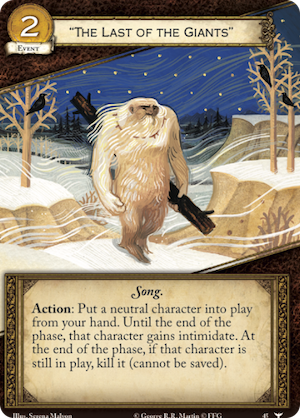
The beautiful artwork is incredibly striking here, with the ‘tapestry’ style of the Song events carrying over in perhaps the most gorgeous scene yet. Or, as Drakey so eloquently put it: “Dude like’s his log. It’s his BFF.â€. However, what’s really interesting here is that its ability is a surprisingly nuanced one with applications one will likely miss on the first readthrough.
First of all it would be remiss of us to not to note this card’s similarity to a Lannister card that already exists in the pool, Hear Me Roar!:
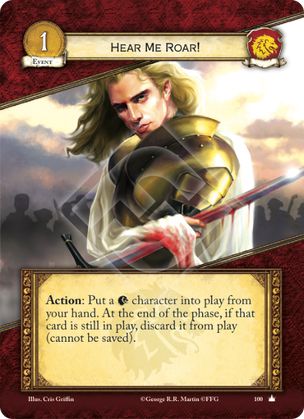
As this lasting effect is worded near-identically (with some small differences discussed below), we can apply the same rulings to this as for Hear Me Roar! already. The rulings are as follows, according to ThronesDB:
“At the end of the phase†effects are delayed effects that initiate (and resolve) in an order decided by the first player - regardless of the order the effects that created them were played. In the case of Hear Me Roar and Tears of Lys, the FP would decide whether that Unique Lannister wound up in the dead pile, or the discard pile. ​After this, reactions to the phase ending (or to that poor, poisoned character dying) proceed in the usual order.
In order to play Hear Me Roar, you check play restrictions, pay costs and choose the target (revealing it) before your opponent decides whether or not to cancel the initiation. This is detailed on page 10 of the RRG under "Initiating Abilities".
There are three small changes:
- Firstly, the gaining of Intimidate. This one is the most straight-forward - the character has Intimidate for the phase, and it runs out at the same time as any other “until the end of the phase†effect does.
- Secondly, the character is killed, rather than discarded. There is no significant rules shenanigans here - cards that interact with a character dying (say, Joffrey Baratheon) can still interact at the end of the phase, just like with the Lannister Harrenhal.
- Thirdly, like Lannister Harrenhal, this card has an important (and more tricksy) distinction with Hear Me Roar! - it specifies that the character is killed if the character is still in play at the end of the phase, not the card. What this means in practice is that you can use it to place a duplicate on a character, and it won’t kill the character at the end of the phase. Why? Because the character you put into play from your hand isn’t a character on the board, it’s a duplicate. This is somewhat niche - one rarely wants to spend 2 gold and an event just to surprise-duplicate a character outside of Marshalling.
In its favour, Giants grants Intimidate. It is more playable than Roar, as it can literally be played by any faction rather than being Loyal for one faction. Being placed in the dead pile rather than the discard pile offers the potential for synergy with the likes of Ghosts of Harrenhal, and potentially others in the future. It also has the Song trait, which - aside from enabling the gorgeous art - could prove relevant some day.
On the flipside, Roar is 1 cheaper, and with Fealty it can in fact be free. It also has other supporting effects (your Never Bets, Harrenhals and the like) to make a coherent deck in a way that Giants currently lacks - it’s more likely to be a slightly off-theme ‘surprise’ card in a deck that otherwise isn’t sporting jumpers. Not killing the character enables tricks with Reinforcements, as well as simply allowing you to play multiple copies of a unique character. Lastly, having no faction affiliation means it’ll count against you in Fealty decks, and cannot be fetched with Shadowblack Lane.
Ultimately the playability of a card such as this will live and die by the characters it can bring in, of course. This is where the card absolutely shines in comparison to Roar, in our opinion. Lannister lacks for characters with enters/leaves play tricks in the current pool, but leaving the card as predominantly a simple “put in a big beefy dude for challenges†effect; the neutral cards, however, let you get a bit more tricksy, and we’ll look at three examples now, in ascending order of relevance.
Firstly, Jaqen H’ghar. This guy has an incredibly powerful effect, but suffers from his 7-cost price-tag and Ally trait. However, his effect to place tokens on people is not a Marshaling effect but an “Enters play†one, meaning this event lets you circumvent that hefty pricetag and get straight to the killing. Sure Jaqen himself will die at the end of the phase, but 2 cards and 2 gold to get a surprise kill on the opponent’s best unique character sounds like a pretty good deal to us.
Secondly, Pyromancers. Like with Jaqen these guys have a powerful removal effect that’s offset by a hefty cost for the effect. Pyros also struggle from needing to remain standing and unperturbed through to the Dominance phase in order to act. Now check that event again - it’s an Action, not limited to merely the Challenges phase. With people increasingly voicing concerns about location-heavy decks taking over the game, we trust that the idea of being able to target-remove locations without worrying about protecting a character through the challenges phase, win a challenge by 5 or anything else could prove of interest?
Now the Pyromancers are one Dominance effect that the neutral cardpool has to offer, but there’s another more potent one that we would like to volunteer as the ultimate use of this card: Varys. Interrupts to a phase ending happen before the phase itself ends, as we have covered before. This means that you can put Varys into play for 2 gold in the dominance phase, and (provided he isn’t struck with Nightmares!) your last, giant Varys will be able to discard the whole board before he’s killed - and best of all, he’ll remove himself from the game to keep himself out of the dead pile and let you repeat the trick later on. Forget Wun-Wun - we would like to posit that it is in fact Varys who is the true Last of the Giants.

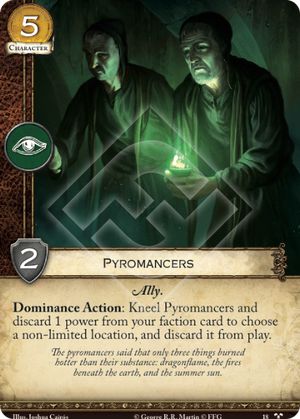
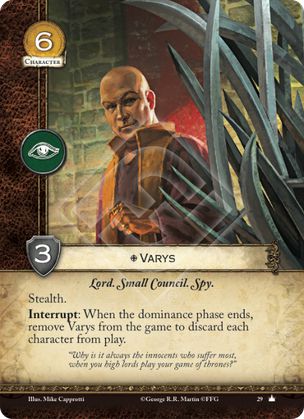
Antti Korventausta (WWDrakey) is a self-proclaimed Finnish AGoT philosopher and doomsayer hermit, who used to practice Quantum Mechanics, but found that it paled to AGoT in both interest and complexity. Having played and judged for more years than he would like to admit, he has found himself on the winning side of rules arguments more than he would expect. In any game he plays, he has a tendency of playing anything he considers to be off the beaten path, whether it makes sense to others or not.
Helmut Hohberger (Ratatoskr) started playing AGoT in September 2010 and has never looked back (although his wife has, longingly). As a German, he loves rules - and I mean *loves* 'em. He is the quintessential rules board morlock. While the others played and frolicked about outside, he sat by candlelight in a remote corner of the library and tried to get a grasp on the intricacies of the 1st edition rules. He even thought he did not do too bad at it, but then the Call of the Three-Eyed Crow drove him into the darkest depths of madness and despair. But he’s all better now, honest, and looking forward to new challenges.
Iiro Jalonen (Ire) Started AGoT in 2009, got pulled under the waves by Krakens years ago, and has never looked back. While not an Oldtown local, he has often been spotted in the Quill & Tankard Inn making sure that the rules of sportsmanship are maintained with the traditional finger dance games. A self-inflicted Shagga and active member of the global AGoT community, he has always strived to know the rules of the game, in order to make them do ridiculous things.
James Waumsley (JCWamma) is a first edition veteran who has judged at multiple large tournaments including the European championship of Stahleck. A renowned loudmouth and pedant, he will shout about the rules loud enough that he can be heard by those north of the wall.
Alex Hynes (Istaril) co-hosts Beyond the Wall, writes articles for FFG, created and curates the Annals - and even tried to fill in ktom’s shoes in the big ktom drought of 2013. When the Regulars asked him to be an honorary member, he, of course, refused and said he didn’t have the time. Or should have, anyway. Still, how much work can being an “Honorary†member be?
- VonWibble, theamazingmrg, mplain and 2 others like this



 Sign In
Sign In Create Account
Create Account












6 Comments
Love you guys. Sharing all these interactions is really helpfull to the community and at the same time spoiling some secret tech is putting me on the fence.
Wildling Scout isn't a terrible use though - get the challenge through first (with a possible intimidate) then sacrifice him for stealth on another guy. Oh, and you get stealth on Ygritte briefly in some cases too.
Tough to get the gold to Ambush if you're paying 2 of your 3 plot gold for the event, though - you'll need a very solid economy base to pull it off.
Very true. But if you're running First Snow without solid economy, then it wasn't going to end well anyway!